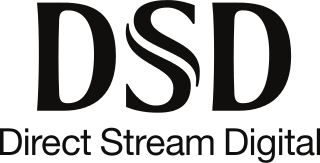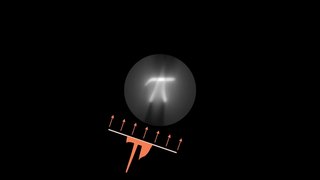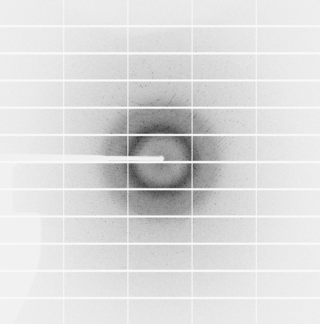Related Research Articles
An audio file format is a file format for storing digital audio data on a computer system. The bit layout of the audio data is called the audio coding format and can be uncompressed, or compressed to reduce the file size, often using lossy compression. The data can be a raw bitstream in an audio coding format, but it is usually embedded in a container format or an audio data format with defined storage layer.
The Au file format is a simple audio file format introduced by Sun Microsystems. The format was common on NeXT systems and on early Web pages. Originally it was headerless, being simply 8-bit μ-law-encoded data at an 8000 Hz sample rate. Hardware from other vendors often used sample rates as high as 8192 Hz, often integer multiples of video clock signal frequencies. Newer files have a header that consists of six unsigned 32-bit words, an optional information chunk which is always of non-zero size, and then the data.

MP3 is a coding format for digital audio developed largely by the Fraunhofer Society in Germany under the lead of Karlheinz Brandenburg, with support from other digital scientists in other countries. Originally defined as the third audio format of the MPEG-1 standard, it was retained and further extended — defining additional bit-rates and support for more audio channels — as the third audio format of the subsequent MPEG-2 standard. A third version, known as MPEG-2.5 — extended to better support lower bit rates — is commonly implemented, but is not a recognized standard.
Waveform Audio File Format is an audio file format standard, developed by IBM and Microsoft, for storing an audio bitstream on personal computers. It is the main format used on Microsoft Windows systems for uncompressed audio. The usual bitstream encoding is the linear pulse-code modulation (LPCM) format.

Digital audio is a representation of sound recorded in, or converted into, digital form. In digital audio, the sound wave of the audio signal is typically encoded as numerical samples in a continuous sequence. For example, in CD audio, samples are taken 44,100 times per second, each with 16-bit sample depth. Digital audio is also the name for the entire technology of sound recording and reproduction using audio signals that have been encoded in digital form. Following significant advances in digital audio technology during the 1970s and 1980s, it gradually replaced analog audio technology in many areas of audio engineering, record production and telecommunications in the 1990s and 2000s.

FLAC is an audio coding format for lossless compression of digital audio, developed by the Xiph.Org Foundation, and is also the name of the free software project producing the FLAC tools, the reference software package that includes a codec implementation. Digital audio compressed by FLAC's algorithm can typically be reduced to between 50 and 70 percent of its original size and decompresses to an identical copy of the original audio data.
MPEG-1 Audio Layer II or MPEG-2 Audio Layer II is a lossy audio compression format defined by ISO/IEC 11172-3 alongside MPEG-1 Audio Layer I and MPEG-1 Audio Layer III (MP3). While MP3 is much more popular for PC and Internet applications, MP2 remains a dominant standard for audio broadcasting.

Direct Stream Digital (DSD) is a trademark used by Sony and Philips for their system for digitally encoding audio signals for the Super Audio CD (SACD).
In bioinformatics and biochemistry, the FASTA format is a text-based format for representing either nucleotide sequences or amino acid (protein) sequences, in which nucleotides or amino acids are represented using single-letter codes.

Tomographic reconstruction is a type of multidimensional inverse problem where the challenge is to yield an estimate of a specific system from a finite number of projections. The mathematical basis for tomographic imaging was laid down by Johann Radon. A notable example of applications is the reconstruction of computed tomography (CT) where cross-sectional images of patients are obtained in non-invasive manner. Recent developments have seen the Radon transform and its inverse used for tasks related to realistic object insertion required for testing and evaluating computed tomography use in airport security.
The General Data Format for Biomedical Signals is a scientific and medical data file format. The aim of GDF is to combine and integrate the best features of all biosignal file formats into a single file format.
Dialogic ADPCM or VOX is an audio file format, optimized for storing digitized voice data at a low sampling rate. VOX files are most commonly found in telephony applications, as well as an occasional arcade redemption game. It uses a lossy compression algorithm, optimized for voice, not high fidelity.

The SEG-Y file format is one of several standards developed by the Society of Exploration Geophysicists (SEG) for storing geophysical data. It is an open standard, and is controlled by the SEG Technical Standards Committee, a non-profit organization.

CRI ADX is a proprietary audio container and compression format developed by CRI Middleware specifically for use in video games; it is derived from ADPCM but with lossy compression. Its most notable feature is a looping function that has proved useful for background sounds in various games that have adopted the format, including many games for the Sega Dreamcast as well as some PlayStation 2, GameCube and Wii games. One of the first games to use ADX was Burning Rangers, on the Sega Saturn. Notably, the Sonic the Hedgehog series since the Dreamcast generation and the majority of Sega games for home video consoles and PCs since the Dreamcast continue to use this format for sound and voice recordings. Jet Set Radio Future for original Xbox also used this format.

PILATUS is the name of a series of x-ray detectors originally developed by the Paul Scherrer Institute at the Swiss Light Source and further developed and commercialized by DECTRIS. The PILATUS detectors are based on hybrid photon counting (HPC) technology, by which X-rays are converted to electrical signals by the photoelectric effect in a semiconductor sensor layer—either silicon or cadmium telluride—which is subject to a substantial bias voltage. The electric signals are counted directly by a series of cells in an ASIC bonded to the sensor. Each cell—or pixel—is a complete detector in itself, equipped with an amplifier, discriminator and counter circuit. This is possible thanks to contemporary CMOS integrated circuit technology.
The Open eXchange Data Format, or OpenXDF, is an open, XML-based standard for the digital storage and exchange of time-series physiological signals and metadata. OpenXDF primarily focuses on electroencephalography and polysomnography.
Fabio Badilini is an Italian scientist and business man. He has made major contributions to noninvasive electrocardiography not only through his individual contributions, but also through his truly remarkable ability to foster collaborations across scientific disciplines, academic institutions, governmental agencies, device manufacturers and industries around the world.
Pulse-code modulation (PCM) is a method used to digitally represent sampled analog signals. It is the standard form of digital audio in computers, compact discs, digital telephony and other digital audio applications. In a PCM stream, the amplitude of the analog signal is sampled at uniform intervals, and each sample is quantized to the nearest value within a range of digital steps.
Synchrotron radiation circular dichroism spectroscopy, commonly referred to as SRCD and also known as VUV-circular dichroism or VUVCD spectroscopy, is a powerful extension to the technique of circular dichroism (CD) spectroscopy, often used to study structural properties of biological molecules such as proteins and nucleic acids. The physical principles of SRCD are essentially identical to those of CD, in that the technique measures the difference in absorption (ΔA) of left (AL) and right (AR) circularly polarized light (ΔA=AL-AR) by a sample in solution. To obtain a CD(SRCD) spectrum the sample must be innately optically active (chiral), or, in some way be induced to have chiral properties, as only then will there be an observable difference in absorption of the left and right circularly polarized light. The major advantages of SRCD over CD arise from the ability to measure data over an extended wavelength range into the vacuum ultra violet (VUV) end of the spectrum. As these measurements are utilizing a light source with a higher photon flux than a bench-top CD machine it means data are more accurate at these extended wavelengths because there is a larger signal over the background noise and, generally, less sample is needed when recording the spectra and there is more information content available in the data. Many beamlines now exist around the world to enable the measurement of SRCD data.
References
- ↑ "Implementation of the EDF File Format in the SAXS Package". European Synchrotron Radiation Facility. n.d. Retrieved 19 September 2022.
- Kemp B, Värri A, Rosa AC, Nielsen KD, Gade J (May 1992). "A simple format for exchange of digitized polygraphic recordings". Electroencephalogr Clin Neurophysiol. 82 (5): 391–3. doi:10.1016/0013-4694(92)90009-7. PMID 1374708. — EDF reference.
- Kemp B, Olivan J (September 2003). "European data format 'plus' (EDF+), an EDF alike standard format for the exchange of physiological data". Clin Neurophysiol. 114 (9): 1755–61. doi:10.1016/S1388-2457(03)00123-8. PMID 12948806. S2CID 36219309.
- Alvarez-Estevez, D. (n.d.). "European Data Format" . Retrieved 19 September 2022.